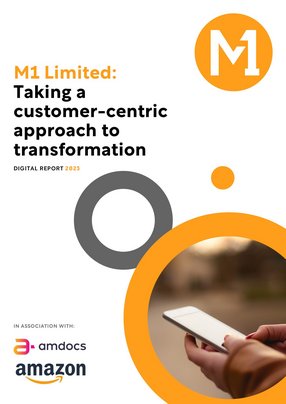M1 Ltd: Taking a customer-centric approach to transformation
Since it first launched commercial services in 1997, M1 Limited has achieved many firsts. It was one of the first operators to be awarded one of Singapore’s two nationwide 5G standalone network licences, the first operator to offer nationwide 4G service, as well as being the first to ultra high-speed fixed broadband, fixed voice and other services on the Next Generation Nationwide Broadband Network (NGNBN).
Today, as a subsidiary of Keppel Corporation, M1 offers a wide range of mobile and fixed communication services to consumers, while delivering an extensive suite of services and solutions to corporate customers including symmetrical connectivity solutions of up to 10Gbps, managed services, cloud solutions, cybersecurity solutions, Internet of Things and data centre services.
A highly competitive market, Singapore today has four different MNOs with several mobile virtual network operators (MVNOs).
“For a city state which has got slightly over five and a half million people, there are quite a lot of operators trying to get their mobile and their fixed line offerings out there in the market,” explains Jan Morgenthal, M1’s Chief Digital Officer.
This role of CDO, he explains, is more involved than a traditionally more strategic position. “I'm actually overseeing the entire IT department, meaning everything from IT strategy down to pulling up the arms and sleeves of the teams going into IT ops.”
About four years ago, M1 wanted to move from being a typical legacy telco operator towards a fully digital operator. “They wanted to really put their entire heart in the business support system (BSS) and operations support system (OSS), and embark on the journey to gain a competitive advantage.” One of those ways, he describes, is through gaining a technological advantage.
“For me, the technology re-haul was at the heart of the digital transformation. We have a consumer and an enterprise business, but our entire consumer business is already more than 95% in the cloud. So actually we have moved almost everything now, except for a couple of legacy items, and some parts that we are not allowed to put into public cloud infrastructure. But everything else will be just going fully into the cloud and that's clearly what we will close by next year.”
In its transformation, what M1 is doing, Morganthal explains, is taking a very customer-centric approach, as part of an ambition to become a digital powerhouse.
“We want to be a fully digital operator, but also to offer made-to-measure offerings, and expand our enterprise business which is a key area for us,” he says.
“We also want to follow up on our regional growth plan. Globally we are not as big as other telco groups - but we want to play smart.”
An example of this smart approach comes through M1’s 5G rollout. As Morgenthal comments, when it came to approaching its 5G rollout, M1 decided to think a little differently - not even embarking on a non-standalone (NSA) journey.
“We just went for standalone (SA) 5G, because of our business strategy. We actually want to offer the best latency and the best connectivity towards our clients.
“We didn't even embark on the NSA journey. That is not something that we believe in, and that is very unique. We went to our local regulator, which is Infocomm Media Development Authority (IMDA), and our 5G SA is actually a joint venture with one of the other mobile operators here locally. And I would say that is a quite unique situation.”
Building the world’s first maritime 5G
M1’s enterprise business has been particularly focused on working on smart 5G solutions. Last year it announced an ambitious project with the aim to provide 5G SA offshore coverage for the southern coast of Singapore.
In collaboration with the Maritime and Port Authority of Singapore (MPA) and the Infocomm Media Development Authority (IMDA), M1 is providing a 5G network to trial, develop and deploy new maritime 5G use cases, in what is the world’s first public and largest maritime testbed at sea.
“We are building the first maritime 5G,” Morgenthal asserts. “The whole southern waterfront of Singapore is the busiest water street in the world.”
This solution has been particularly beneficial following the COVID-19 pandemic, in what has turned into a win-win for all parties. “If the seafarer felt sick during COVID-19, there was no way for them to anchor in Singapore, and come in on land, because there were of course strict regulations.
“That is a clear 5G use case, where you need to have low latency and other benefits, and it's actually a win-win situation for all of us. The port authority is happy that they can provide something to the ships, the seafarers are happy, and we are also happy because we found a good use case.”
The use of 5G connectivity includes telemedicine to enable crew welfare at sea, delivery drones, maritime surveillance, and autonomous vessels, as well as remotely controlled task-based robots, such as ship inspection and autonomous fire-fighting robots, that are used for more dangerous and labour-intensive tasks.
“It's nice that you can talk to a doctor or nurse, but there comes the point where you need to get the medicine to the seafarer, for example. So we worked with a partner, which is building these drones, to perform the last mile delivery so that we can deliver items - medicine in this case - from the Singapore main island towards the boats, all using our 5G network.
“That is something which we can build not in a matter of years, but within weeks. Because we are a little bit more nimble than some of our competitors, we can act much faster and smarter to deploy solutions and provide a win-win-win situation for everyone.”
AWS and Amdocs: Working with partners who share a similar mindset
As Morgenthal explains, M1 works with a number of key partners such as Amazon Web Services (AWS) and Amdocs on M1’s digital transformation.
“As we embarked on a digital transformation, we were also looking for partners who are of the same mind.” By working with significant players in the industry, M1 can see the benefits.
“Even though we are maybe rather a small operator in Singapore, they see us actually as the digital innovator in our business, in Singapore and the region.
“When something is working out here in Singapore very well, then it's also a good showcase for them to go to our neighbouring countries and show them. That's actually what both of them are definitely giving back to us.”
Morgenthal adds that it is important for M1 to have partners who are market leaders and have a strong track record, not just in innovation but also in joint execution leveraging the power of public cloud.
“I also want to have those partners who share a similar cultural approach to M1,” he explains. “We need to open our eyes and actually foresee the future, as best as we can, and plan for it. Because I think one thing is very clear: in 10 years, telcos won't be the same, and I think we need to shape our future by ourselves.
“That's what I also like about AWS and Amdocs. Both of them share a strong focus on customer-centricity and a desire to fundamentally re-invent on behalf of the customer by leveraging technology. I want to work with partners that have a similar view on what is actually needed for pushing the next boundary of digital transformation.”
The aim to be a fully cloud-native digital operator
For M1, the future involves the continued transformation of moving from a traditional legacy operator towards a cloud-native digital operator. “We embarked six months ago upon our enterprise transformation. So that's clearly something which, especially in my heart, I will still drive this digital transformation until the end of 2024, with the aim to also have a fully cloud-native setup for our enterprise businesses.”
Having successfully trialled the 5G maritime rollout, M1 will also be working to deploy further 5G use cases in the immediate future
“We are continuing to work to deploy more 5G use cases here in Singapore: we want to show more the true value of 5G and how we can actually embark on it.
“5G will dominate more of the B2B space, but we're also offering and getting more into the B2B2C space so that our consumers can actually see the real benefits of 5G, and why they actually start using 5G.”
Central to this, Morgenthal comments, is maintaining a customer-centric view.
“If we kept the same service product portfolio that we had five years ago, then obviously the consumer will ask, ‘what is in it for me?’
“That is clearly something we need to work on, to give our customers the right offerings. For consumers, it is something we need to take into consideration.
“In the past, most telcos lost touch with their customers. And that was an opportunity for the hyperscalers to actually move into that space and actually create content and services, based on the connectivity layer.
“Today, most telcos, including what we are doing at M1, can now once again offer such services to our end clients. In the past, we lost touch as an industry, and we need to become much more customer-centric again.”




- Powering a Smartphone with AI: Apple and OpenAI in TalksTechnology & AI
- Manish Mangal Becomes Tech Mahindra CTO for Telecom BusinessTelecommunications
- A New Chapter for the World’s Largest Technical OrganisationTechnology & AI
- Extreme Labs Launch: A Networking Hub for R&D and InnovationTechnology & AI


